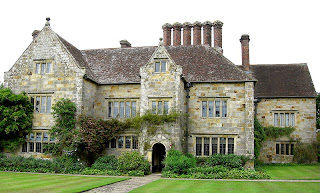Monday, May 16
It is an hour's drive from Heathfield in Sussex to Leeds Castle in Kent. There is an historic connection between Leeds Castle and Virginia. In the 1600's the Culpeper family owned Leeds Castle, and John, the 1st Lord Culpeper was granted all the land bounded by the Potomac and Rappahannock Rivers in Virginia; more than five million acres of land in in reward for assisting the escape of the Prince of Wales during the English Civil War.
 Thomas Fairfax, the 6th Lord Fairfax of Cameron, and son of Thomas and Catherine Culpeper, was born at Leeds Castle in 1693, and later settled permanently in the Virginia Colony to oversee the Culpeper estates. Virginia's Culpeper County and Fairfax County owe their names to the link to Leeds Castle. In fact there is a commemorative sundial at Leeds Castle telling the time in Belvoir, VA and a corresponding sundial in Belvoir telling the time at Leeds Castle.
Thomas Fairfax, the 6th Lord Fairfax of Cameron, and son of Thomas and Catherine Culpeper, was born at Leeds Castle in 1693, and later settled permanently in the Virginia Colony to oversee the Culpeper estates. Virginia's Culpeper County and Fairfax County owe their names to the link to Leeds Castle. In fact there is a commemorative sundial at Leeds Castle telling the time in Belvoir, VA and a corresponding sundial in Belvoir telling the time at Leeds Castle. The earliest construction of the present castle was begun in the early 1100's, although a manor house occupied the same site as far back as the 9th century. Eventually the castle was bought in 1926 by an Anglo-American woman who became Lady Baillie. In her will she left the castle and grounds to the National Trust, and it was opened to the public in 1976.
We enjoyed the touring the castle, and the grounds and gardens outside the moat. I had fun walking through the maze that was built in 1988 using 2,400 yew trees to form the impenetrable ten foot high walls of the labyrinth.




